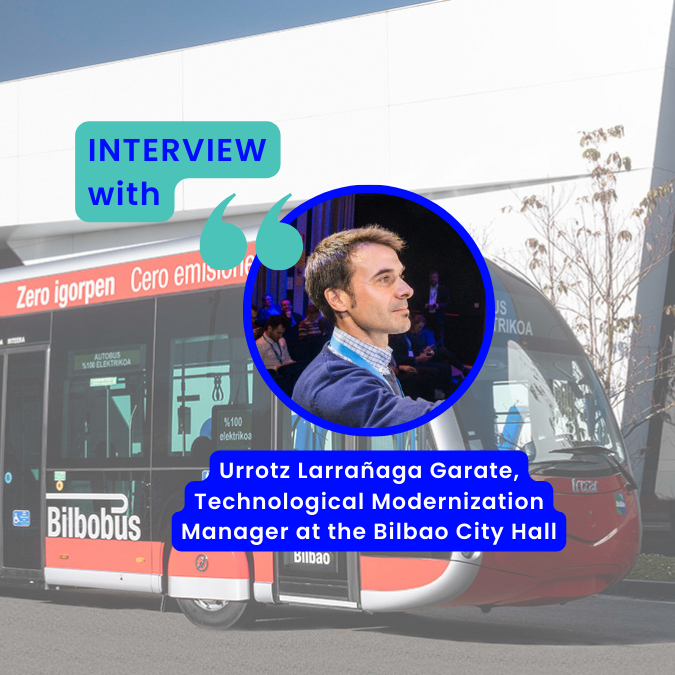Citio, which was selected a few months ago by the Reach project, has entered the testing phase of the “Demand Analysis and Occupancy Prediction in Bilbobus” project in collaboration with the city of Bilbao. We interviewed Urrotz Larrañaga Garate, the Technological Modernization Manager at the Bilbao City Hall, to get an update on the progress and know how it is going so far.
Q1: What challenges do you aim to address with the “Demand Analysis and Occupancy Prediction in Bilbobus” project?
Urrotz Larrañaga Garate (ULG): “From a global perspective, the goal of the project is to analyze mobility demand in a simple and effective way, which will allow us to improve the strategic planning of different routes and services provided by our bus service.
Currently, we are conducting a study to reorganize bus lines in order to make them more effective and improve quality for our users. We will also have the opportunity to use your software to receive feedback on this.
In the future, the solution obtained through this project may enable us to more effectively identify deficiencies and possible improvements in the service, so we can adapt more effectively to user demand.
On the other hand, there is the occupancy prediction part. From a more specific perspective, we will be able to calculate the occupancy of each bus, allowing us to communicate this information to the users. This information will help them to choose the bus in which they will travel. This is very positive for us because it will improve the quality of service offered and will help to avoid overcrowding, which was a real concern during the COVID-19 pandemic. We believe this information will continue to be valuable to many users, as it is the feedback we received from them.”
Q2: How were you aware there was a concern from the population about overcrowding?
ULG: “The use of buses decreased significantly due to people’s fear of being surrounded by too many people during the pandemic. This was a critical issue in many cities, prompting them to start providing information about bus occupancy through apps or information boards at bus stops. We also recognized the importance of addressing this issue and decided to take action.
Moreover, we have received numerous requests from people with disabilities, for example those in wheelchairs, who are concerned about bus occupancy levels. It is crucial for them to know whether the bus is crowded or not, and we aim to address this concern.”
Q3: What are your expectations from Citio in this project?
ULG: “We hope that collaborating with Citio will allow us to gain a more detailed understanding of the solution you propose, and experiment with it to determine if it can meet our previously mentioned objectives.
In our interactions with Citio’s teams so far, we have found you to be diligent and highly skilled professionals, who truly understand the subject matter. We are confident that this project will be a success, and that it will help us improve our bus service.”
Q4: What are your success criteria for this trial?
ULG: “One of the main criteria for success will be the accuracy of the occupancy prediction system. It seems almost magical when we think about it, so we are eager to see if it will actually work. Specifically, we want to test the system’s accuracy by comparing your predicted occupancy levels to the real occupancy levels on the buses. This is one of the key points we want to check.
Additionally, we are excited to explore the friendliness and usability of your software. We want to see how it can be used to help us with our analysis needs, such as calculating the indicators we require. We are looking forward to delving into everything your software has to offer.”
Q5: What, in your opinion, were the main reasons that led to Citio being selected by REACH for this project?
ULG: “The primary reason for selecting your proposal was its maturity as a solution. While the other projects were more conceptual and theoretical, your proposal was more tangible with more visible aspects and fewer things to be taken on faith.
Additionally, your knowledge of the transport sector was a differentiator. Although the other proposals were also technologically attractive, they did not demonstrate as much experience in managing all the factors involved in the transportation sector and bus management.”
Q6: What can you say about the project and the collaboration with Citio so far?
ULG: “We are still in one of the initial phases of the project. For the moment, we have mainly focused on sharing the information that your software requires. Even in these early stages, we have received valuable feedback from your team regarding the quality of our information. This feedback helped us discover some cases that we were not previously aware of, and we now have a better understanding of the information we possess. The collaboration has been very positive so far and we are excited to see how the project goes on.”
Other resources on the subject
We have already written several articles on the Reach x Bilbao / Bilbobus x Citio project:
- You can read our first article about the collaboration;
- Our second article explaining the reasons for our selection;
- To learn more about Reach, click here;
- To learn more about Bilbobus, the public transportation network of Bilbao, click here.
